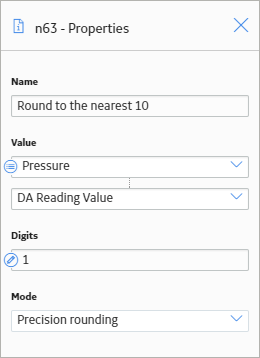When you use decimal rounding, you can specify the number of decimal places to which you want to round the input value. For example, if the input value is 3.51 and you indicate that you want to round to the nearest tenth (by specifying the value 1 in the Digits text box on the Properties window), the input value will be rounded to 3.5.
When you use precision rounding, you can specify the number of digits that you want keep from the input value. For example, if the input value is 7,658,321 and you indicate that you want to keep the first three values (by specifying the value 3 in the Digits text box on the Properties window), the input value will be rounded to 7,660,000 (where the third digit, 5, is rounded to 6, and the remaining digits are changed to 0).
Note: The Round node always rounds values to the nearest number (i.e., you can not specify that it always round values up or down). To round values up or down, you can use a Remainder node with an Add or Subtract node.

